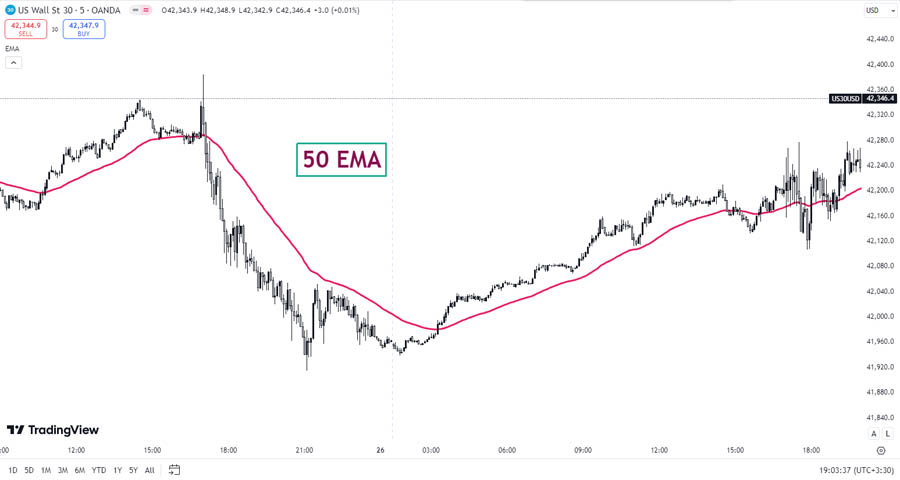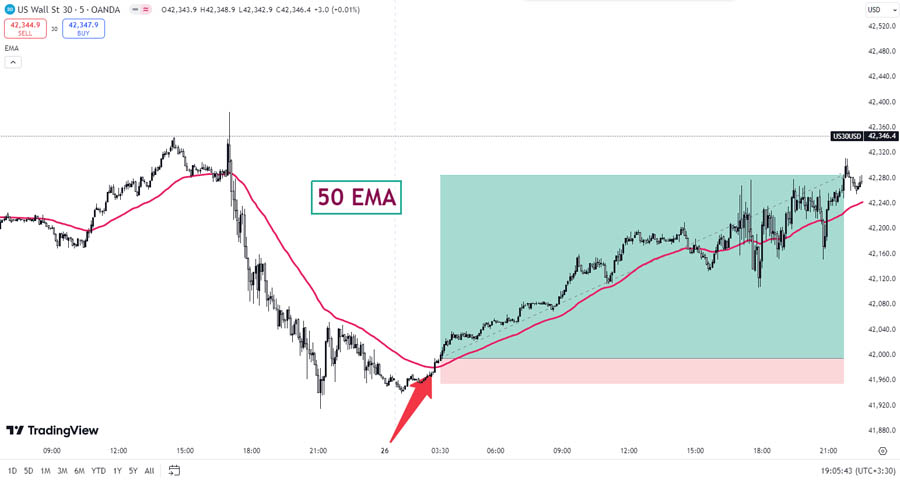The 50 EMA scalping strategy is a powerful forex trading technique that combines the 50-period Exponential Moving Average (EMA) with short-term trading tactics to potentially generate quick profits in the currency markets. This strategy allows traders to identify and capitalize on short-term price movements while staying aligned with the overall market trend, making it an effective tool for both novice and experienced forex traders working with online forex brokers.

Are you ready to take your forex trading to the next level? The 50 EMA scalping strategy offers a unique approach to navigating the fast-paced world of currency trading. By mastering this technique, you can potentially enhance your trading performance, increase your win rate, and achieve more consistent results in the forex market.
In this comprehensive guide, we’ll break down the 50 EMA scalping strategy into easy-to-understand components, providing you with actionable insights and expert tips to implement this approach in your own trading routine. We’ll cover everything from the basics of the 50 EMA and scalping to advanced techniques and common pitfalls to avoid. Whether you’re a seasoned pro or just starting your forex journey, this article will equip you with the knowledge and tools you need to potentially boost your trading success.
By the end of this guide, you’ll have a solid understanding of:
- How the 50 EMA scalping strategy works and why it’s effective
- Step-by-step instructions for implementing the strategy in your trading
- Advanced techniques to refine your approach
- Common mistakes to avoid and tips for success
- How to adapt the strategy to different market conditions
Let’s dive in and unlock the secrets of the 50 EMA scalping strategy to potentially revolutionize your forex trading approach.
Read More: Master the 20 EMA Scalping Strategy
Understanding the 50 EMA Scalping Strategy

What is the 50 EMA?
The 50-period Exponential Moving Average (EMA) is a popular technical indicator used by traders to identify trends and potential entry and exit points. Unlike a simple moving average, the EMA gives more weight to recent price data, making it more responsive to current market conditions.

The 50 EMA is particularly useful because it strikes a balance between being sensitive enough to recent price action and providing a reliable indication of the overall trend. When price is above the 50 EMA, it generally suggests an uptrend, while price below the 50 EMA indicates a potential downtrend.
The Basics of Scalping
Scalping is a trading style that involves making numerous trades within a short time frame, usually aiming to profit from small price movements. Scalpers typically hold positions for a few minutes to a few hours, making it an exciting but demanding approach to forex trading.
The key advantages of scalping include:
- Potential for frequent profits
- Reduced exposure to long-term market risks
- Ability to capitalize on short-term market inefficiencies
However, scalping also comes with challenges such as:
- Increased transaction costs due to frequent trading
- Higher stress levels from constant market monitoring
- Need for quick decision-making and disciplined execution
Combining 50 EMA and Scalping
The 50 EMA scalping strategy merges the trend-following capabilities of the 50 EMA with the quick-fire nature of scalping. This powerful combination allows traders to identify potential entry points in the direction of the overall trend while capitalizing on short-term price fluctuations.
By using the 50 EMA as a dynamic support and resistance level, traders can:
- Identify the overall trend direction
- Spot potential entry points when price reacts to the 50 EMA
- Set logical stop-loss and take-profit levels based on the EMA’s position
This approach helps traders align their short-term trades with the broader market momentum, potentially increasing the probability of successful trades.
Read More: Unveiling the 9 EMA Scalping Strategy
Key Components of the 50 EMA Scalping Strategy

1. Timeframe Selection
For effective 50 EMA scalping, most traders focus on shorter timeframes such as the 5-minute, 15-minute, or 1-hour charts. These timeframes provide enough price action for scalping opportunities while still allowing the 50 EMA to offer meaningful trend information.
When selecting a timeframe, consider the following factors:
- Your trading style and temperament
- The typical volatility of your chosen currency pairs
- Your ability to monitor the markets and execute trades quickly
Many traders find the 15-minute chart to be a sweet spot for the 50 EMA scalping strategy, as it offers a good balance between frequent trading opportunities and meaningful trend information.
2. Trend Identification
The 50 EMA acts as a dynamic support and resistance level. When price is above the 50 EMA, it generally indicates an uptrend, while price below the 50 EMA suggests a downtrend. Traders using this strategy look to trade in the direction of the overall trend.
To identify trends using the 50 EMA:
- Look at the slope of the EMA line (upward slope indicates uptrend, downward slope indicates downtrend)
- Observe how price interacts with the EMA (bouncing off it as support in uptrends or resistance in downtrends)
- Consider the position of the EMA relative to other key levels on your chart
Remember, the 50 EMA is just one tool for trend identification. For a more comprehensive analysis, you may want to combine it with other trend-following indicators or price action analysis.
3. Entry and Exit Rules
Clear entry and exit rules are crucial for successful implementation of the 50 EMA scalping strategy. Here’s a detailed breakdown:
Entry Rules:
- For long trades:
- Confirm an uptrend (price above 50 EMA, EMA sloping upwards)
- Wait for price to pull back to the 50 EMA
- Look for bullish candlestick patterns or other confirmation signals near the EMA
- Enter when price shows signs of bouncing higher from the EMA
- For short trades:
- Confirm a downtrend (price below 50 EMA, EMA sloping downwards)
- Wait for price to rally to the 50 EMA
- Look for bearish candlestick patterns or other confirmation signals near the EMA
- Enter when price shows signs of resuming the downward movement from the EMA
Exit Rules:
- Set a tight stop loss, typically just beyond the recent swing high or low
- Take profits quickly, often using one of these methods:
- Fixed pip target (e.g., 10-20 pips depending on the currency pair and timeframe)
- When price reaches the next significant support/resistance level
- When price shows signs of losing momentum (e.g., formation of reversal candlestick patterns)

It’s important to note that these rules should be adapted to your specific trading style and risk tolerance. Some traders may prefer to use trailing stops to maximize profits in strong trends, while others may opt for scaling out of positions to secure partial profits early.
4. Risk Management
Proper risk management is crucial in scalping. Most experienced traders risk no more than 1-2% of their account balance on a single trade. Use a position size calculator to determine the appropriate lot size based on your stop loss and risk tolerance.
Key risk management principles for 50 EMA scalping:
- Always use a stop loss to protect your capital
- Keep your risk-to-reward ratio favorable (aim for at least 1:1.5 or better)
- Be prepared to exit trades quickly if market conditions change
- Monitor your overall exposure and avoid overtrading
Remember, consistent profitability in forex trading comes from effective risk management as much as it does from a good entry strategy.
Read More: Unlock Profitable Trading with the 3 EMA Scalping Strategy
Implementing the 50 EMA Scalping Strategy

Step 1: Set Up Your Chart
- Open your preferred trading platform and select a currency pair.
- Choose a suitable timeframe (e.g., 15-minute chart).
- Add the 50-period EMA to your chart.
- (Optional) Add any additional indicators you use for confirmation, such as RSI or MACD.
Ensure your chart is clean and easy to read. Too many indicators can lead to analysis paralysis and hinder quick decision-making.
Step 2: Identify the Trend
Observe the relationship between price and the 50 EMA:
- If price is predominantly above the 50 EMA, consider an uptrend.
- If price is predominantly below the 50 EMA, consider a downtrend.
- If price is frequently crossing the 50 EMA with no clear direction, the market may be ranging.
In ranging markets, it’s often best to wait for a clear trend to emerge before attempting to scalp.
Step 3: Wait for a Pullback
In an uptrend, wait for price to pull back to the 50 EMA. In a downtrend, wait for price to rally to the 50 EMA.
Patience is key in this step. Avoid the temptation to enter trades prematurely, as this can lead to suboptimal entry points and increased risk.
Step 4: Look for Confirmation
Before entering a trade, look for additional confirmation signals such as:
- Candlestick patterns (e.g., bullish engulfing in an uptrend, bearish engulfing in a downtrend)
- Support/resistance levels coinciding with the 50 EMA
- Momentum indicators (e.g., RSI showing oversold conditions in an uptrend or overbought conditions in a downtrend)
- Volume spikes indicating strong interest at the 50 EMA level
The more confluence factors you have, the higher the probability of a successful trade.
Step 5: Execute the Trade
Once you have confirmation, enter the trade in the direction of the overall trend. Place your stop loss and take profit levels according to your predetermined risk management rules.
Be prepared to act quickly, as scalping opportunities can disappear rapidly. However, avoid rushing into trades without proper confirmation.
Step 6: Monitor and Exit
Closely monitor the trade and be prepared to exit quickly. Remember, scalping is about taking small, frequent profits rather than holding out for large gains.
Keep an eye on:
- Price action near your take profit level
- Any signs of momentum loss or potential reversal
- News events that could impact your trade
Don’t be afraid to exit a trade early if it’s not behaving as expected. Protecting your capital should always be your primary concern.
Advanced Techniques for 50 EMA Scalping

1. Multiple Timeframe Analysis
Incorporate higher timeframes to gain a broader perspective on the overall trend. For example, if scalping on a 15-minute chart, check the 1-hour and 4-hour charts to ensure you’re trading in line with the bigger picture.
Benefits of multiple timeframe analysis:
- Improved trend identification
- Better entry and exit timing
- Reduced likelihood of trading against major market forces
2. Combining with Other Indicators
Enhance your 50 EMA scalping strategy by incorporating complementary indicators:
- MACD: Use for additional trend confirmation and momentum analysis.
- RSI: Identify overbought or oversold conditions for potential reversals.
- Bollinger Bands: Gauge volatility and potential price targets.
- Stochastic Oscillator: Spot potential turning points in price.
Remember, while additional indicators can provide valuable insights, they should complement your strategy, not complicate it. Avoid indicator overload, which can lead to confusion and missed opportunities.
3. Price Action Analysis
Develop your skills in reading price action to improve trade timing and increase your win rate. Look for key candlestick patterns, support and resistance levels, and chart patterns in conjunction with the 50 EMA.
Important price action elements to consider:
- Candlestick patterns (e.g., doji, hammer, engulfing patterns)
- Chart patterns (e.g., triangles, flags, pennants)
- Support and resistance levels
- Round numbers (psychologically significant price levels)
Combining price action analysis with the 50 EMA can help you make more informed trading decisions and spot high-probability setups.
4. Adapting to Market Conditions
Be prepared to adjust your strategy based on current market conditions:
- In ranging markets, consider using the 50 EMA as both support and resistance for mean reversion trades.
- During high-volatility periods, widen your stop loss and take profit levels to accommodate larger price swings.
- In trending markets, look for pullbacks to the 50 EMA as potential entry points.
- During major news events, consider staying out of the market or adjusting your risk parameters.
Flexibility is key to long-term success in forex trading. The ability to adapt your strategy to changing market conditions will help you maintain consistency in your trading results.
Common Pitfalls and How to Avoid Them
- Overtrading: Stick to your predetermined rules and avoid the temptation to enter every possible setup.
- Ignoring the bigger picture: Always consider the higher timeframe trend to avoid trading against strong market forces.
- Neglecting risk management: Consistently apply proper position sizing and stop loss placement to protect your capital.
- Emotional trading: Develop and follow a trading plan to minimize the impact of emotions on your decision-making.
- Failing to adapt: Regularly review and refine your strategy to stay in sync with changing market conditions.
Tips for Success with 50 EMA Scalping
- Practice in a demo account: Master the strategy in a risk-free environment before trading with real money.
- Keep a trading journal: Track your trades and analyze your performance to identify areas for improvement.
- Focus on high-probability setups: Be patient and wait for trades that meet all your criteria.
- Manage your expectations: Scalping requires discipline and consistency; don’t expect to get rich overnight.
- Stay informed: Keep up with economic news and events that could impact your chosen currency pairs.
Opofinance Services
For traders looking to implement the 50 EMA scalping strategy with a reliable and regulated forex broker, Opofinance stands out as an excellent choice. As an ASIC-regulated broker, Opofinance offers a secure and transparent trading environment, ensuring that your funds and personal information are well-protected.

One of the standout features of Opofinance is its innovative social trading service. This platform allows you to connect with and learn from experienced traders, potentially accelerating your learning curve and improving your trading results. Whether you’re new to forex or an experienced scalper, the social trading feature can provide valuable insights and opportunities.
Opofinance’s commitment to providing a top-tier trading experience is further evidenced by its inclusion on the official MT5 brokers list. This means you’ll have access to the powerful MetaTrader 5 platform, which is ideal for implementing advanced strategies like 50 EMA scalping.
Additionally, Opofinance offers safe and convenient deposit and withdrawal methods, ensuring that you can manage your trading capital with ease and confidence. With a range of account types to suit different trading styles and experience levels, Opofinance provides the tools and support you need to succeed in the fast-paced world of forex scalping.
Conclusion
The 50 EMA scalping strategy offers a powerful approach to forex trading, combining the trend-following capabilities of the 50-period Exponential Moving Average with the quick profits potential of scalping. By mastering this strategy and avoiding common pitfalls, you can potentially enhance your trading performance and achieve more consistent results in the forex market.
Remember, successful trading is a journey, not a destination. Continuously educate yourself, practice in a demo account, and refine your approach based on your experiences and market conditions. With dedication, discipline, and the right tools at your disposal, you can work towards becoming a proficient 50 EMA scalper and potentially unlock new levels of forex trading success.
How does the 50 EMA scalping strategy differ from other popular forex strategies?
The 50 EMA scalping strategy stands out for its unique combination of trend-following and quick-profit potential. Unlike longer-term strategies that may use multiple indicators or focus on larger price movements, this approach leverages the 50-period Exponential Moving Average to identify short-term trading opportunities aligned with the overall trend. It’s particularly well-suited for traders who enjoy fast-paced action and have the discipline to manage multiple trades within short time frames.
Can the 50 EMA scalping strategy be applied to other financial markets besides forex?
While the 50 EMA scalping strategy is primarily used in forex trading, it can be adapted to other financial markets with sufficient liquidity and volatility. For example, it could potentially be applied to certain stocks, indices, or even some cryptocurrency pairs. However, it’s important to note that each market has its own characteristics, and traders should thoroughly test and adjust the strategy to suit the specific dynamics of their chosen market before implementing it with real capital.
How important is the choice of currency pairs when using the 50 EMA scalping strategy?
The choice of currency pairs is crucial when employing the 50 EMA scalping strategy. Ideally, you should focus on major pairs or highly liquid minor pairs that exhibit consistent volatility and tight spreads. Pairs like EUR/USD, GBP/USD, or USD/JPY are popular choices among scalpers due to their high trading volume and generally predictable behavior. It’s advisable to avoid exotic pairs or those with wide spreads, as these can significantly impact your profitability when scalping small price movements.







